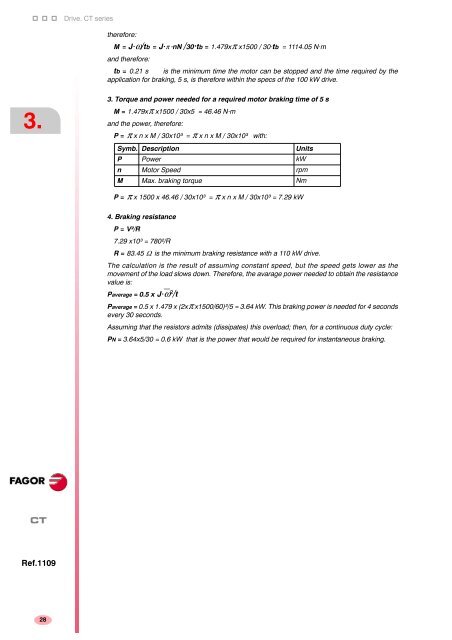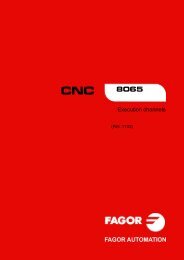6. - Fagor Automation
6. - Fagor Automation
6. - Fagor Automation
You also want an ePaper? Increase the reach of your titles
YUMPU automatically turns print PDFs into web optimized ePapers that Google loves.
Drive. CT series<br />
3.<br />
CT<br />
Ref.1109<br />
28<br />
therefore:<br />
M = J·ω/tb = J·π ·nN /30·tb = 1.479xπ x1500 / 30·tb = 1114.05 N·m<br />
and therefore:<br />
tb = 0.21 s is the minimum time the motor can be stopped and the time required by the<br />
application for braking, 5 s, is therefore within the specs of the 100 kW drive.<br />
3. Torque and power needed for a required motor braking time of 5 s<br />
M = 1.479xπ x1500 / 30x5 = 4<strong>6.</strong>46 N·m<br />
and the power, therefore:<br />
P = π x n x M / 30x10³ = π x n x M / 30x10³ with:<br />
Symb. Description Units<br />
P Power kW<br />
n Motor Speed rpm<br />
M Max. braking torque Nm<br />
P = π x 1500 x 4<strong>6.</strong>46 / 30x10³ = π x n x M / 30x10³ = 7.29 kW<br />
4. Braking resistance<br />
P = V²/R<br />
7.29 x10³ = 780²/R<br />
R = 83.45 Ω is the minimum braking resistance with a 110 kW drive.<br />
The calculation is the result of assuming constant speed, but the speed gets lower as the<br />
movement of the load slows down. Therefore, the avarage power needed to obtain the resistance<br />
value is:<br />
Paverage = 0.5 x J·ω²/t<br />
Paverage = 0.5 x 1.479 x (2xπ x1500/60)²/5 = 3.64 kW. This braking power is needed for 4 seconds<br />
every 30 seconds.<br />
Assuming that the resistors admits (dissipates) this overload; then, for a continuous duty cycle:<br />
PN = 3.64x5/30 = 0.6 kW that is the power that would be required for instantaneous braking.

















